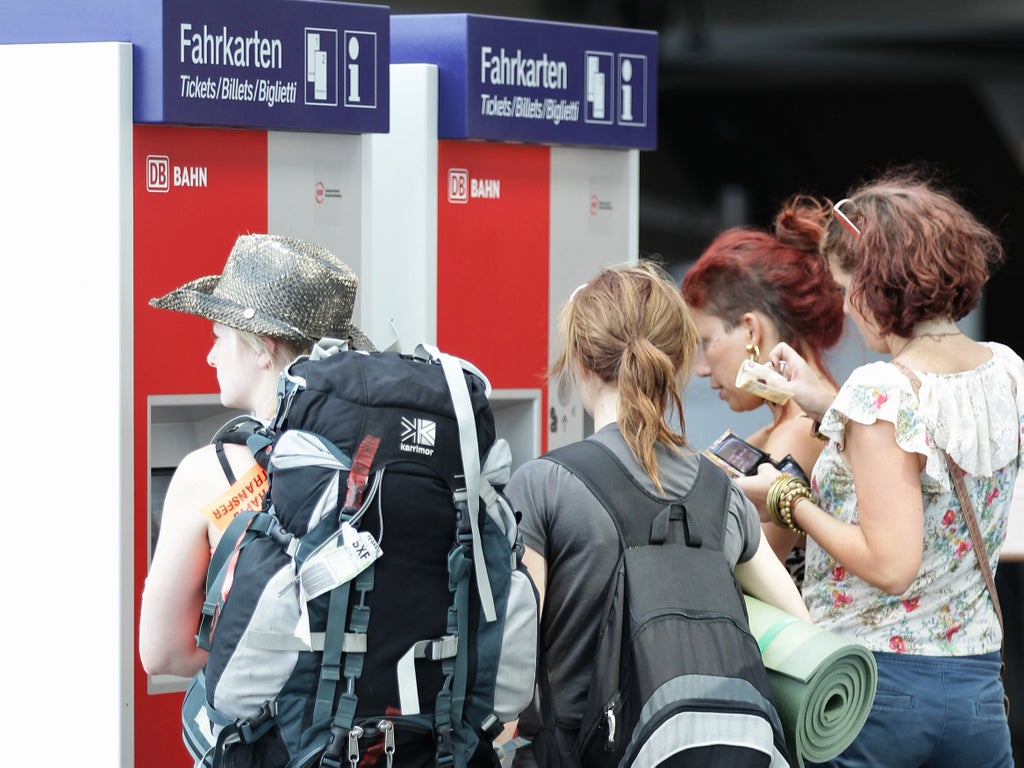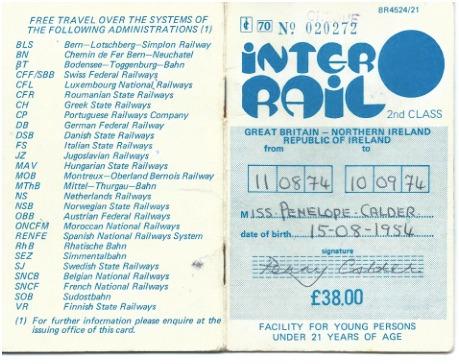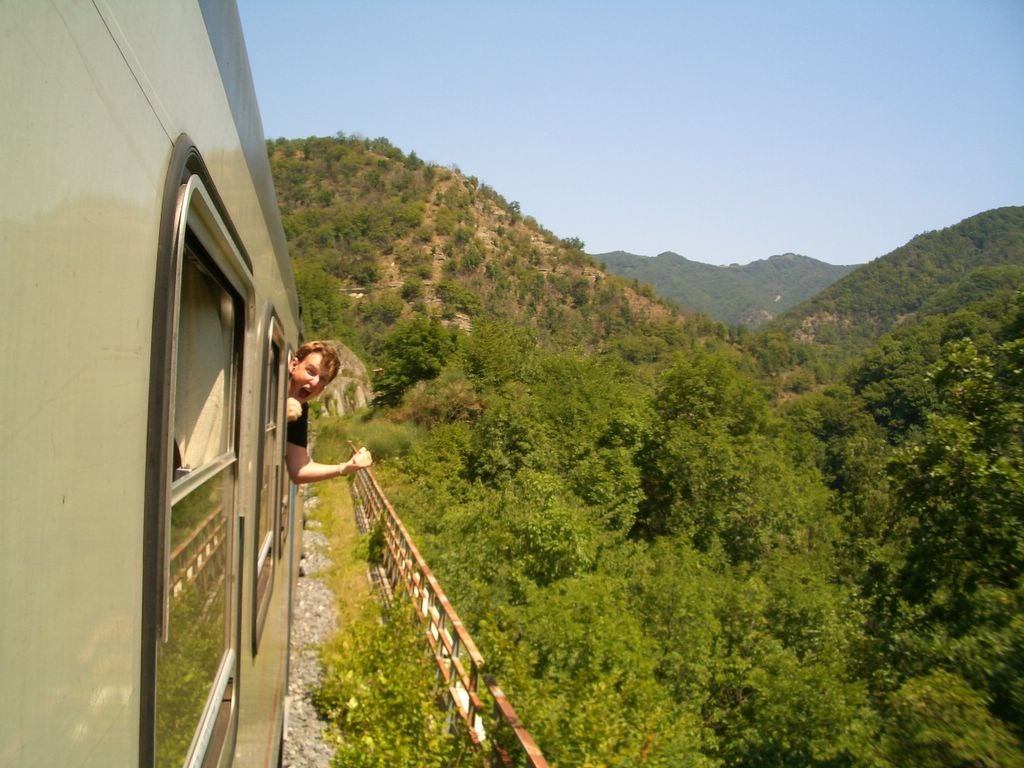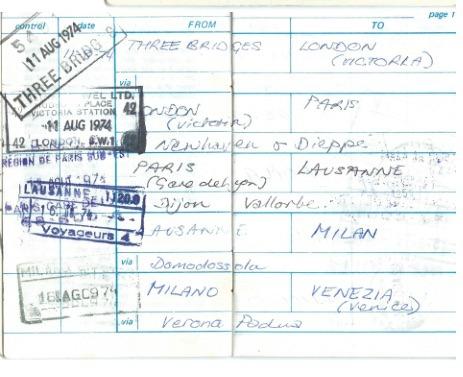
In 1972, a flurry of new postage stamps emerged as countries across Europe marked the half-centenary of the International Union of Railways (UIC). Belgium and Romania stepped up to the mark – as did plucky Monaco, with a handsome commemorative issue showcasing trains that surely never ran on Monaco’s limited rail network (which is just over one mile).
The stamps have been consigned to philatelic history, but not so another initiative sponsored by UIC to mark its 50th anniversary. UIC’s European members launched a remarkable rail pass designed to give young Europeans the freedom to roam the continent.
That pass was called Interrail, and it created a travel revolution. Starting in the spring of 1972, any European resident up to 21 years old could buy a one-month Interrail pass valid in 21 countries.
Initially, it was a strictly limited experiment, on offer only until the autumn of 1972. Yet decades before the dawn of budget airlines, the pass proved immensely popular. With almost no publicity, 87,000 passes were sold to young people to explore their continent. Along the way they demonstrated an enviable ability to sleep almost anywhere.
Interrail became a mainstream offer, and moved beyond a privilege of youth. Age limits were dropped in 1998.
Europe before Interrail
In truth, Interrail did not come out of the blue. A pass for visitors from outside Europe allowing the freedom of the continent’s railways had been available 13 years earlier: Eurail. It was the creation of an unassuming Frenchman called Pierre Le Bris who, from his base in San Francisco, worked closely with the French national rail operator SNCF and the US-based Rail Europe agency.
Le Bris realised the difficulties that Americans visiting Europe had in booking train tickets in advance. His canny, pre-internet idea was to liberate these visitors by letting them use a rail pass which afforded a real freedom to roam.
Rail Europe Inc sold the first Eurail passes in 1959 and before long the company was shaping itineraries that showcased European cities and landscapes – helping create in the American imagination an idealised view of a Europe sweeping from Paris through the Rhineland, the Alps and the Riviera to northern Italy.
Cheap thrills
In 1971, a heavily discounted Eurail pass for students was introduced. The post-1968 beat generation was on the move, guitars in hand, and they came in their thousands, keen to explore not merely the canonical sights that featured in the Rail Europe posters but also eager to take in places off the beaten path.
Young Europeans were quick to question the logic that underpinned Eurail. “Why,” they asked, “should young Americans and other overseas visitors get a great value rail pass to explore Europe, while we who live here on the continent cannot benefit from this offer?”
The pressure was on, and it was no surprise when in 1972 the national rail administrations of 21 countries responded with a scheme geared fair and square at young Europeans. They launched Interrail: a rail pass that covered a much larger area than Eurail.

And the rest is railway history
Few could have imagined how a modest initiative would develop so successfully, profoundly shaping European travel and our shared understanding of our common European home.
The Interrail scheme is still a collaborative programme of Europe’s national rail operators. In the early days it was restricted to young people, but today’s passes are equally popular with families and retirees.
The Interrail pioneers of 1972 are now aged about 70, and many are still venturing out with their passes – most of them now using the new mobile versions of Interrail.
“It’s not as good as it used to be”
Half a century of roaming the rails in Europe induces many rose-tinted memories. We’ve heard many Interrail veterans suggest that the pass scheme isn’t the same as in the early days. The reason: the supplements and advance booking requirements, particularly for using high-speed trains in France (including Eurostar and Lyria) and Spain.
But we need to put the record straight. There was never a time in the early days of the pass when Interrailers could just hop on any train without bothering about reservations.
It is part of Interrail mythology that there was a great moment in history when the pass cost hardly anything and one could travel on any train. Interrail always came laced with restrictions. The entire Trans-Europe Express (TEE) network was simply out-of-bounds to pass holders in 1972. This was not a question of having to pay a supplement; TEE was a complete no-go area for Interrail travellers.
Prime-time departures from Zurich to Munich (on the Bavaria), Hamburg (the Helvetia) and Paris (L’Arbalète) were barred to pass holders. The same applied to sensibly timed morning trains from Milan to Geneva (the Lemano), Nice (the Ligure), Lyon (the Mont Cenis) and Munich (the Mediolanum).

France was as difficult for the Interrail pioneers as it can still be today. The fastest trains on key routes from Paris to the provinces (eg on the lines to Toulouse and Clermont-Ferrand as well as on services to Alsace and the Rhone Valley) were all first-class only and thus not available to Interrail pass holders.
Even more annoyingly, Interrail was barred on some regional services where alternatives were slow or circuitous. For example, Interrail was not valid on the only Rapide of the day from Nantes and Tours to Lyon. Perversely, or so it seemed to pass holders, SNCF would not accept Interrail on the sole daily direct train from Bordeaux to Grenoble.
Many trains on prime routes to the Adriatic resorts of what was then Yugoslavia were barred to holders of Interrail passes. So pass holders could not use the Marjan Express from Zagreb to Split, the Arena from Zagreb to Pula or the fastest trains from Zagreb to Rijeka.
Similarly, the Sarajevo Express from Belgrade to Sarajevo was a no-go zone for holders of an Interrail pass.
The secret of rail pass success
The early users of Interrail passes worked around a tangle of restrictions. Barred from premium services, they took slower options. They did not complain, but rejoiced at being able to travel from Norway to Italy without having to pay a cent beyond that initial outlay for an Interrail pass.
That is still perfectly possible today. Nothing has changed except the horizons of a new generation of travellers where high-speed and long-distance are seen as virtues in their own right.
As Interrail turns 50, now is the time to rediscover the slow trains which, being free of supplements and restrictions, are perfectly suited to Interrail. If you want to speed across France on a TGV, the option is there – but you’ll need to book a seat and pay a supplement. That means committing yourself to a particular itinerary.
Interrail is all about having the freedom to explore: flexibility, stopping off on a whim, and savouring the serendipitous discoveries and diversions that come with Slow Travel. One of our favourite writers, an early exponent of Slow Travel, is Theophile Gautier. “What charm can there be in a journey when one is always sure to arrive?,” queried Gautier in 1843.
Perhaps Interrail’s fullest potential is yet to be realised. It’s a gift that allows us to escape the rush of modernity and to rediscover a slower Europe.
Get on board
What better way to slip from work into retirement than with a three-month pass allowing the freedom to roam Europe? At current prices (March 2022), anyone aged 60 or over would pay €974 (£810) for a three-month first-class pass. That’s just £9 a day. And with a special flash half-price sale to mark the half-century, available until 11.59pm on 10 May, prices for one-, two- and three-month “global passes” are halved.
Interrail has equally been discovered by families. Two adults with two children (aged 8 and 10, by way of example) will pay €604 (£504) for passes giving the group of four unlimited second-class rail travel for seven days within a month across more than 30 countries.
The available network extends from the far north of Scandinavia to the Mediterranean, from western Ireland to Turkey’s border with Iraq. Of those European countries with regular scheduled passenger trains, Interrail is valid in all but six of them. The exceptions are Russia, Belarus, Ukraine, Moldova, Kosovo and Albania.
The westernmost station to which a pass can be used is Tralee in southwest Ireland, at more than 9.5 degrees west of Greenwich. The eastern extremity of pass validity is Kapıkoy in eastern Turkey at over 44 degrees east.
The northernmost rail route where passes are valid is the line from Abisko in northern Sweden to the Norwegian port of Narvik. There the railway runs to more than 68 degrees north.
In the long-gone days when Morocco was covered by Interrail, it was possible to ride the rails all the way to Marrakech, but these days the southernmost station covered by Interrail is Algeciras in southern Spain: just over 36 degrees north, and thus just pips İskenderun in Turkey’s Hatay region, which is a shade closer to the North Pole.
Over 32 degrees of latitude and almost 54 degrees of longitude just waiting to be discovered – and the perfect challenge for anyone using a three-month Interrail pass. Has anyone has ever reached Interrail’s four cardinal points in a single trip?

Interrail milestones
1972 – Interrail launches as a one-month, second-class pass for under-21s, valid in 21 countries. The price in sterling is £32.
1976 – Age limit increases to 23. East Germany drops out of the scheme but Romania and Morocco join.
1979 – Age limit increases to 29 and a new senior pass is offered, including a first-class option.
1989 – First restricted offer of passes for people of all ages, initially only trialled in Nordic countries.
1994 – Now that there are 29 participating countries, zonal passes are introduced covering separate parts of Europe. There is a choice of a one-month pass covering multiple zones, but now, for the first time, a 15-day pass covering just a single zone is available.
1998 – ‘Not just for youths with smelly socks’: Interrail drops all age limits.
2007 – The zonal system is dropped, with the choice now being between the global pass valid right across Europe or a single-country Interrail pass. This new range of one-country passes effectively replaces the former EuroDomino range of tickets which allowed unlimited rail travel within a single country.
2010 – New youth-adult-senior pricing structure, with wider availability of first-class passes.
2015 – New family offer with children under 12 travelling for free with an adult.
2018 – Discover EU programme starts, offering complimentary passes to 18-year-old Europeans.
2019 – Interrail and Eurail schemes effectively converge, while still retaining distinct brand identities. Lithuania joins the scheme. Britain talks about leaving, but then backtracks and stays.
2020 – Cautious launch of the very first mobile passes. Estonia and Latvia join the scheme.
2021 – Mobile passes are chosen by 96 per cent of travellers purchasing Interrail.
2022 – Europe marks 50 years of Interrail, though in a muted way against the backdrop of war in Ukraine.
Nicky Gardner is editor of hidden europe and co-author of Europe by Rail: The Definitive Guide. The 17th edition of the book has just been published.







